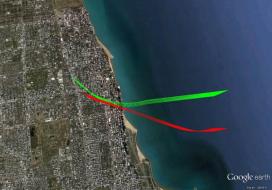Assessing the Safety of National Airspace System Upgrades
Cutting-edge modeling and simulation tools developed by Volpe are enhancing the way the Federal Aviation Administration (FAA) assesses the safety of upgrades to the National Airspace System (NAS). These tools enable rigorous analysis of procedures, equipment, and airspace in the NAS.
The Challenge
The NAS is a complex network of airways, airports, air navigation facilities, and air traffic control facilities with technology, rules, and regulations intended to facilitate safe and efficient air travel. Air travel is expected to increase in the coming decades, and FAA is exploring ways to improve capacity in the NAS without sacrificing safety.
The Solution
Volpe’s team of pilots, engineers, physicists, mathematicians, computer scientists, operations research analysts, and system engineers developed a number of modeling and simulation tools to examine the safety of NAS improvements.
Among these, Volpe created a Monte Carlo-based computer simulation tool that enables rigorous analysis of procedures, equipment, and airspace in the NAS. This simulation tool includes stochastic models, also known as probability-based models, of almost every element in the NAS—mechanical, electronic, and human—including pilots, air traffic controllers, wind conditions, and surveillance systems.
As part of this capability, Volpe also developed the following:
- Kinematic aircraft models: Provides detailed specs on numerous modern aircraft so that researchers can accurately show what will happen to a range of airplanes in different weight classes in a wide variety of scenarios.
- High-performance random number generator: Allows researchers to run tens of thousands of scenarios—for instance, simulating response times from air traffic controllers within various time windows.
- WGS-84-compliant elliptical Earth model: Provides precision for calculating minute but critical data, such as the curvature of the earth.
- Graphical interface: Provides photo-realistic airport depictions and real-time 3-D animation.
The main software tool is considerably large and labor intensive, as reflected in SLOCCount-calculated values of 143,934 lines of code and a development effort estimated to be 36.91 person-years.
The Impact
Volpe’s work provides government-owned, exhaustively-validated analytical capability that supports safe development of air traffic procedures for the Next Generation Air Transportation System and beyond. This work also produces extensive statistical summaries, graphical visualizations, and animations for a wide range of aviation safety-critical scenarios. The separation tool gives the FAA confidence that capacity in the NAS can be increased by allowing planes to fly closer to one another while maintaining stringent safety standards.

A simulation depicting the track of an air traffic controller-directed aircraft’s evasion maneuver (green) in response to a parallel-tracking aircraft erroneously departing from its course (red). (Google Earth image)
